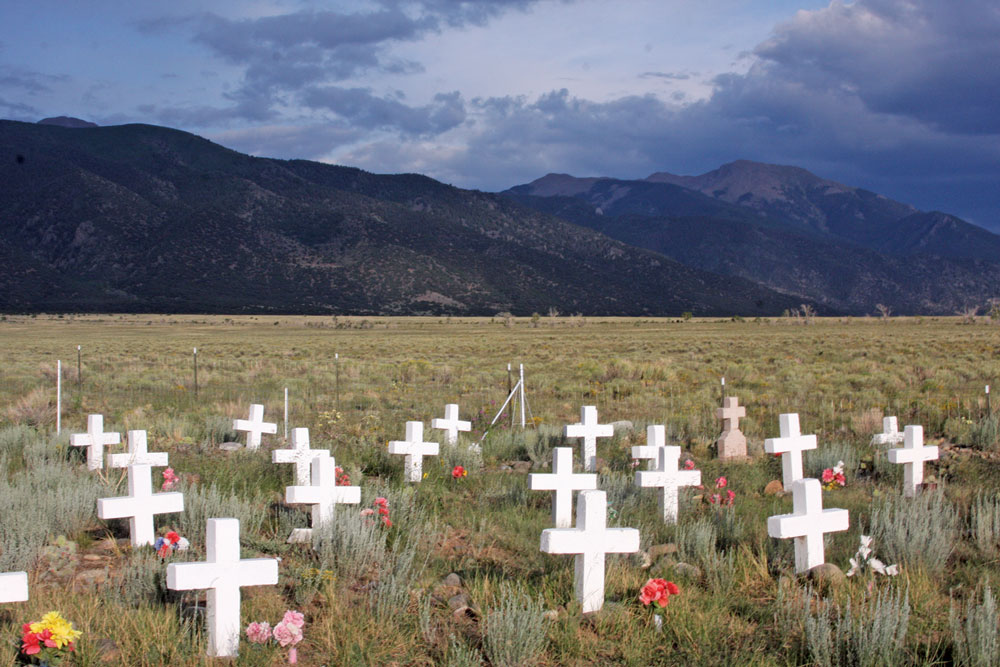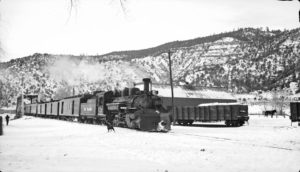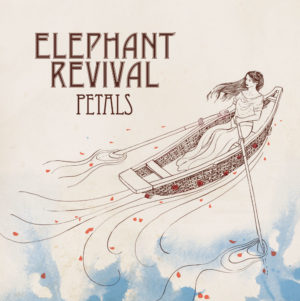
In the northern San Luis Valley, southeast of Villa Grove, are two remote and obscure cemeteries: the Cotton Creek and the Mirage. At one time, the area was home to a small settlement of Hispanics who worked at the nearby Orient Mine and also raised sheep. The Cotton Creek Cemetery is where many of them are buried.
The cemetery sat abandoned for many years until a group of descendants decided to restore it, beginning in 2009. Over a three-year period, they secured 70 cement crosses to replace rock mounds, erected fencing and produced name plates for some of the graves. A replica of a small chapel which had burned down at the site was built and holds mementos of many who are buried there.
Surnames of those buried there include Martinez, Atencio, Mardena, Valdez and Duran.
There has not been a burial at the cemetery since before World War II, but the restoration has provided a tribute to those buried there after years of neglect. A dedication of the restoration was held on Aug. 4, 2012.
The Mirage Cemetery, located on Lower Cotton Creek, is the resting place for many Anglo settlers of the region, many of whom were soldiers of German descent who had been stationed at Fort Garland. After the fort was closed, many filed homestead claims to farm and raise their families. Names such as Hoffman and Bruning can be found there. The first known burial was in 1889. It is now considered abandoned.
Following is a story about the Mirage written by John Mattingly, who farmed the area in the 1980s.
“When I came to the San Luis Valley in 1986 to manage Cotton Creek Ranch, the Mirage Cemetery was located inside the outer arc of one of the center pivots on the ranch. In a 2006 piece for Colorado Central, I detailed my meeting with Mary Pavlin of Pueblo, then the manager of Mirage Cemetery, in which I eventually persuaded her to allow me to operate the pivot through the cemetery.
The previous owner of the ranch had lost control of a ditch-burning operation, with the result that the wooden grave markers in the cemetery had been reduced to ash, so Mary was not impressed with farmers at that point, and it took several months of conversations and concessions before she finally trusted me enough to allow the pivot to pass through. It was a great advantage to me to allow this passage because it gave the pivot a full 360-degree rotation.
One thing I learned in these conversations with Mary was that the bodies were three deep in the Mirage Cemetery, and it was for Anglos only. The Spanish and Indians were buried a couple of miles east on the south bank of Cotton Creek in a separate cemetery known as Cotton Creek Cemetery.
In the Mirage Cemetery, I learned how many of the people had died. A surprising number passed away from relatively minor accidents but failed to get over Poncha Pass to medical care due to weather or mechanical breakdowns. There was one inimitable, immortal character buried in Mirage Cemetery named Wilbur Mills, whose picture reminded me of Ed Quillen. Wilbur had been bucked off his horse and landed on his head, and survived. Not only that, he’d been shot several times in various extremities including his left foot, he’d survived swine flu, typhoid and multiple twisted bowel incidents, he’d wrestled with Indians, been gored by a bull and billy goat on separate occasions, suffered two heart attacks, and had a wife who owned a sharp tongue. He drank whiskey for breakfast and had a hand-rolled Bugler stuck to his lips most of the time. Wilbur finally died in his sleep at 93. He was buried in the top layer of one of the three-story interments in Mirage Cemetery.
[InContentAdTwo]
Keeping Wilbur in mind, I return to Mary Pavlin. We never drew up a formal agreement regarding the pivot passage, but one of the details was that there had to be special gates in the cemetery fence at the four points where the pivot passed through. Only two towers of the pivot were involved, but the towers had to enter and leave precisely in their tracks.
I got together with the crew at the ranch and we designed the gates on spring hinges so the tires would open the gates upon arrival and the gates would close as the last tire exited. By the time we were installing the gates, the grass had grown up knee high or thereabouts, and the Mirage Cemetery was somewhat of a vegetative jungle. We were tasked with mowing the grass once we had the gates installed.
As we were putting the final touches on the last gate, a terrible moan emanated from inside the cemetery. It sounded like a human dying an awful, agonizing death, not unlike Antonine Artaud’s stage enactment of a man dying of the plague, performed in Paris in 1923 as a surrealist protest against the bourgeois fear of disease – a reference lost on my hired men. But they were more concerned than curious and refused to enter the cemetery to investigate. So I volunteered. Being the boss, I really had no choice.
High-stepping my way through the grass, certain there was a rational explanation, I came upon an elk calf, writhing in a mat of thatch, foaming at the mouth, its eyes rolled back into it head. With a somber face, I returned to the men at the gate and grabbed a shovel, silently leaking an expression of firm resignation.
When I put the poor creature out its misery, it let out a death whelp of epic proportions, to which I could not resist responding, “Wilbur, get back in your grave and stay there!”
I kid you not: the two men working for me dashed to their pickup and drove back to the shop.
To get there: Cotton Creek Cemetery – From Hwy. 17, south of Villa Grove, turn east on C.R. AA. After five miles, turn north on Road 64 and continue for 2 1/4 miles. The cemetery is on the east side of the road.
Mirage Cemetery – From Hwy. 17, south of Villa Grove, turn east on C.R. AA. After three miles, turn north on Road 62 for one mile. Turn east on Road BB for 1 1/4 mile. The cemetery is on the east side of the road. The old town of Mirage, on lower Cotton Creek is 1 1/4 miles south of the turn on AA.



